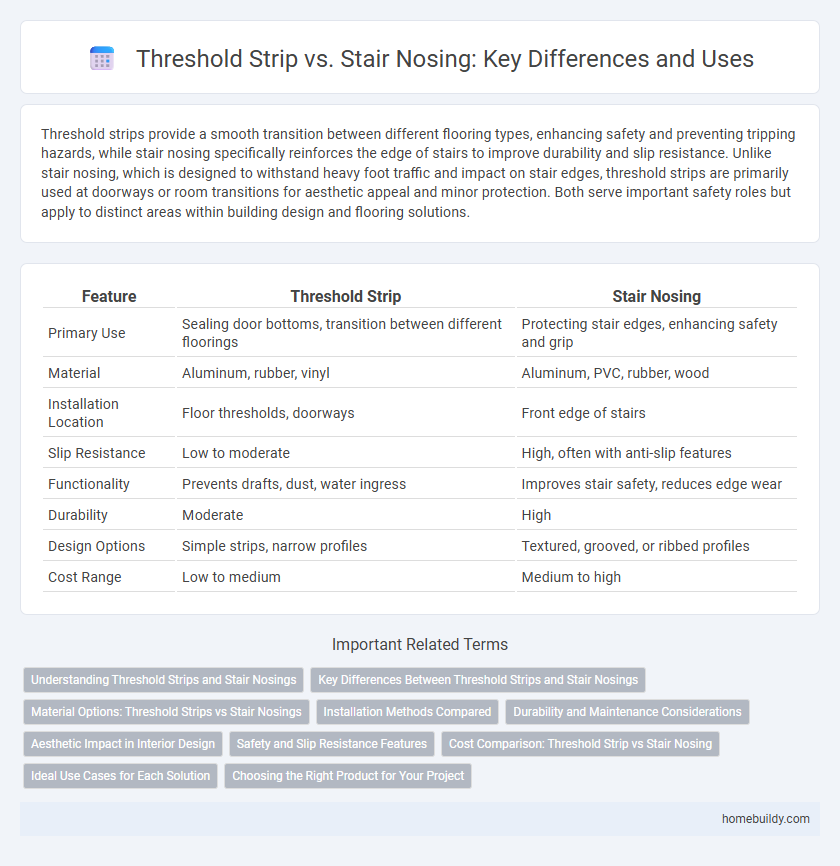Threshold strips provide a smooth transition between different flooring types, enhancing safety and preventing tripping hazards, while stair nosing specifically reinforces the edge of stairs to improve durability and slip resistance. Unlike stair nosing, which is designed to withstand heavy foot traffic and impact on stair edges, threshold strips are primarily used at doorways or room transitions for aesthetic appeal and minor protection. Both serve important safety roles but apply to distinct areas within building design and flooring solutions.
Table of Comparison
| Feature | Threshold Strip | Stair Nosing |
|---|---|---|
| Primary Use | Sealing door bottoms, transition between different floorings | Protecting stair edges, enhancing safety and grip |
| Material | Aluminum, rubber, vinyl | Aluminum, PVC, rubber, wood |
| Installation Location | Floor thresholds, doorways | Front edge of stairs |
| Slip Resistance | Low to moderate | High, often with anti-slip features |
| Functionality | Prevents drafts, dust, water ingress | Improves stair safety, reduces edge wear |
| Durability | Moderate | High |
| Design Options | Simple strips, narrow profiles | Textured, grooved, or ribbed profiles |
| Cost Range | Low to medium | Medium to high |
Understanding Threshold Strips and Stair Nosings
Threshold strips provide a smooth transition between different flooring surfaces, enhancing safety and preventing tripping hazards at doorways. Stair nosings are specifically designed to protect stair edges, improve slip resistance, and increase visibility on staircases. Understanding the distinct functions and applications of threshold strips and stair nosings is essential for selecting the appropriate safety solution in building design.
Key Differences Between Threshold Strips and Stair Nosings
Threshold strips primarily serve as transition pieces between different flooring types, providing a smooth surface to prevent tripping hazards, while stair nosings enhance stair safety by increasing tread visibility and slip resistance. Stair nosings typically feature a textured or beveled edge designed to improve grip and highlight stair edges, whereas threshold strips prioritize sealing gaps and accommodating height differences between floors. The materials used for stair nosings often include durable metals or enhanced rubber, contrasting with threshold strips that may utilize wood, vinyl, or aluminum for seamless floor transitions.
Material Options: Threshold Strips vs Stair Nosings
Threshold strips and stair nosings differ significantly in material options tailored to their specific applications and durability requirements. Threshold strips commonly use materials like aluminum, rubber, and vinyl to provide weather resistance, flexibility, and ease of installation in doorways. Stair nosings, designed for high-traffic safety, often feature robust materials such as aluminum, stainless steel, and durable rubber with anti-slip inserts to enhance tread safety and wear resistance.
Installation Methods Compared
Threshold strips typically require surface mounting with screws or adhesive, allowing for straightforward installation on doorways and floor transitions. Stair nosing installation often involves both mechanical fasteners and adhesives, ensuring secure attachment to stair edges for enhanced safety and durability. The installation complexity for stair nosing is generally higher due to the need for precise alignment and increased wear resistance.
Durability and Maintenance Considerations
Threshold strips typically offer greater durability compared to stair nosing due to their solid construction and resistance to wear in high-traffic entryways. Maintenance of threshold strips is generally easier as they accumulate less dirt and require less frequent replacement than stair nosing, which faces constant impact and abrasion. Choosing threshold strips over stair nosing can reduce long-term upkeep costs while maintaining floor integrity.
Aesthetic Impact in Interior Design
Threshold strips offer a seamless transition between rooms with minimal visual disruption, enhancing the overall aesthetic harmony of interior spaces. Stair nosing, designed for safety and durability, often features more pronounced profiles that can draw attention away from sleek design elements. Choosing a threshold strip over stair nosing allows for cleaner lines and a subtler finish, ideal for modern, minimalist interiors where understated elegance is desired.
Safety and Slip Resistance Features
Threshold strips provide a smooth transition between different floor surfaces, enhancing safety by reducing trip hazards at doorways. Stair nosing features slip-resistant materials and protrudes slightly over the stair edge to improve traction and visibility, significantly decreasing the risk of slips and falls on staircases. Both products prioritize slip resistance, but stair nosing is specifically designed to address the unique challenges of stair safety with its textured, anti-slip surfaces and durable construction.
Cost Comparison: Threshold Strip vs Stair Nosing
Threshold strips generally cost less than stair nosing due to simpler materials and installation processes. Stair nosing often requires durable, slip-resistant materials and precise fitting, increasing both product and labor expenses. Budget-conscious projects typically favor threshold strips for cost efficiency while maintaining basic safety features.
Ideal Use Cases for Each Solution
Threshold strips are ideal for doorways and transitions between different flooring types, providing a smooth passage and preventing tripping hazards. Stair nosing is specifically designed for stair edges, enhancing safety by increasing traction and protecting the stair surface from wear. Use threshold strips for flat floor transitions and stair nosing for staircases requiring extra grip and durability.
Choosing the Right Product for Your Project
Threshold strips provide a smooth transition between different flooring surfaces, ideal for doorways and entrances, while stair nosing enhances safety and durability on stair edges by preventing slips and protecting stair treads from wear. Selecting the right product depends on the specific function of the area--threshold strips suit areas requiring floor height equalization, whereas stair nosing is designed for high-traffic stairways needing increased grip and visibility. Understanding the distinct purposes and installation requirements ensures optimal safety, durability, and aesthetic appeal for your flooring project.
Threshold strip vs Stair nosing Infographic

 homebuildy.com
homebuildy.com